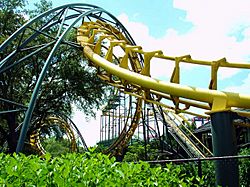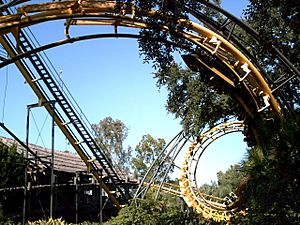Python (Busch Gardens Tampa Bay) facts for kids
Quick facts for kids Python |
|
|---|---|
| Previously known as The Python | |

Python's double-corkscrew element (chain lift and first drop in background)
|
|
| Busch Gardens Tampa Bay | |
| Location | Busch Gardens Tampa Bay |
| Park section | Congo |
| Coordinates | 28°02′20″N 82°25′30″W / 28.0390°N 82.4251°W |
| Status | Removed |
| Opening date | July 1, 1976 |
| Closing date | October 31, 2006 |
| Cost | US$2 million ($10.3 million in 2022 dollars ) |
| Replaced by | Jungala |
| General statistics | |
| Type | Steel |
| Manufacturer | Arrow Development |
| Designer | Ron Toomer |
| Model | Corkscrew |
| Lift/launch system | Chain lift hill |
| Height | 72 ft (22 m) |
| Length | 1,200 ft (370 m) |
| Speed | 40 mph (64 km/h) |
| Inversions | 2 |
| Duration | 1:08 |
| Height restriction | 42 in (107 cm) |
| Python at RCDB | |
Python was an exciting steel roller coaster at Busch Gardens Tampa Bay theme park in Tampa, Florida. It was built by a company called Arrow Development. Python first opened on July 1, 1976.
This made it the very first roller coaster at Busch Gardens since the park opened in 1959! Python was located in the Congo area of the park. It was near other fun rides like Stanley Falls Flume and later the Congo River Rapids.
After 30 years of thrills, Python closed its doors on October 31, 2006. The area where it stood was later replaced by Jungala. This is a family-friendly section of the park.
Python was a special type of roller coaster known as a "Corkscrew" model. Arrow Development built several of these, similar to the famous Corkscrew at Knott's Berry Farm. Python reached a height of about 22 meters (72 feet). It could go as fast as 64 kilometers per hour (40 mph). The track was about 366 meters (1200 feet) long. When it first opened, people really enjoyed the ride.
Contents
The Story of Python
Busch Gardens Tampa was growing a lot in the 1970s. After adding new attractions like the Skyride, park officials started planning their next big expansion. In September 1975, they announced a brand new thrill ride: "The Python."
This new roller coaster was going to be super fast, reaching speeds of 80 kilometers per hour (50 mph). It would also have a 15-meter (50-foot) drop! Building Python cost $2 million. This was part of a bigger $7.6 million plan to make the park even better. Everyone expected Python to open by the summer of 1976.
In early 1976, park officials said that the new expansion, including Python, would have something for everyone. They wanted the park to be balanced and fun for all ages. Construction of Python began, and by April and May 1976, you could see the ride taking shape.
Python officially opened on July 1, 1976. It was a big deal because it was the first roller coaster at Busch Gardens Tampa. It was also the very first roller coaster in Florida to have inversions, meaning it turned riders upside down!
Why Python Closed
In September 2006, people started hearing rumors that Python might close. Busch Gardens was looking into plans to change the Congo area where the roller coaster was. The park wanted to build a large new section there.
On October 28, 2006, Busch Gardens announced that Python would not open for the 2007 season. The ride officially closed forever on October 31, 2006. It had been thrilling riders for 30 years!
After Python was taken down, its ride cars were sent to another park. They went to Busch Gardens Williamsburg to be used on their roller coaster called Loch Ness Monster. The new area at Busch Gardens Tampa Bay, which replaced Python, was approved in June 2007. It became Jungala, and it opened on April 5, 2008.
How Python Was Built
Python was a standard model roller coaster made by Arrow Development. It was a copy of another famous ride, the Corkscrew roller coaster. That original Corkscrew was first at Knott's Berry Farm and now operates at Silverwood in Athol, Idaho.
It took Arrow Development six years to perfect the design for the Corkscrew model. The main designer was a person named Ron Toomer.
When Python first opened, its track was painted bright yellow and brown. Later, it was changed to a black and yellow color scheme. Python used two trains at a time. Each train had six cars, and two riders could sit side-by-side in each row. This meant 24 riders could go on the ride at once.
The trains were also black and yellow. This was because the roller coaster was themed after the python snake! Riders had to be at least 42 inches tall to ride. The trains had special restraints that went over your head to keep you safe.
What the Ride Was Like
Your adventure on Python began when the train left the station. It made a quick turn to the right. Then, it started climbing up the 22-meter (72-foot) lift hill.
Once you reached the top, the train dipped into a banked turn to the right. Then, it plunged down the first big drop! As you went down, the train reached its fastest speed of 64 kilometers per hour (40 mph).
After the drop, the train went up a small hill that was also banked to the right. This led into a turn, and then came the most exciting part: the double corkscrew! This is where the ride turned you upside down twice in a row.
After the awesome double corkscrew, the train went through another turn to the right. Finally, it entered the brake run, where it slowed down and returned to the station. One full ride on Python took about one minute to complete.
Images for kids



